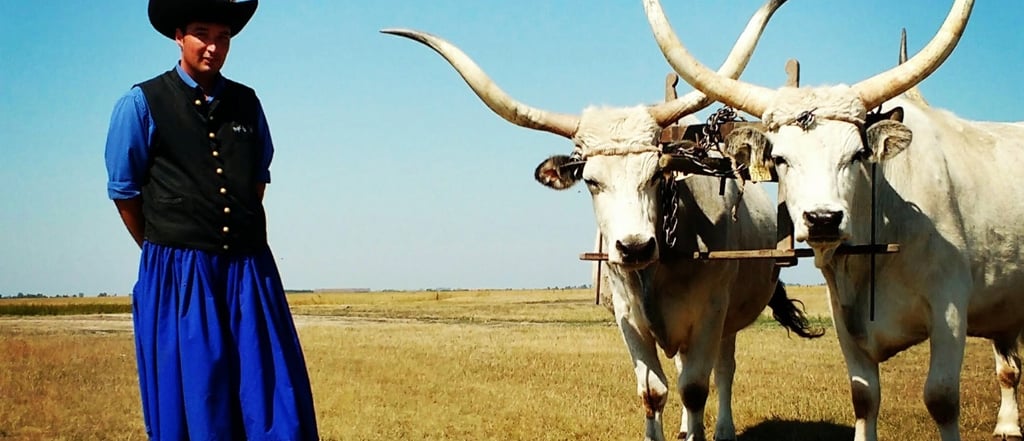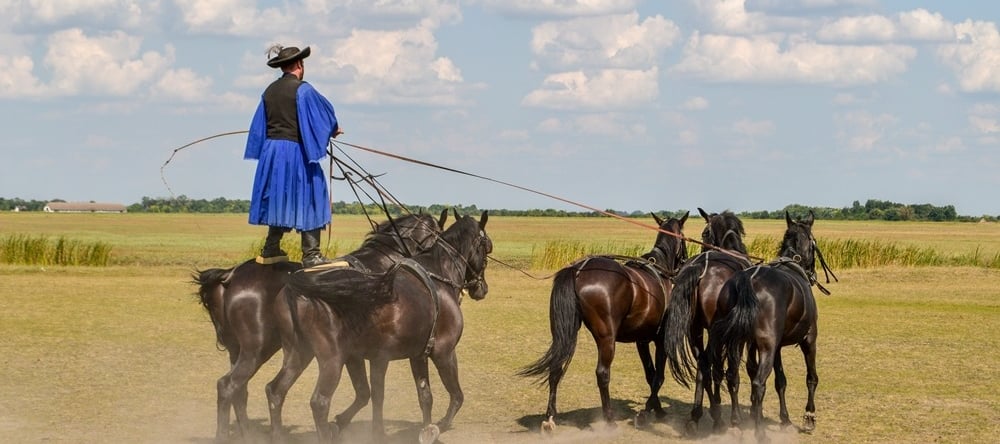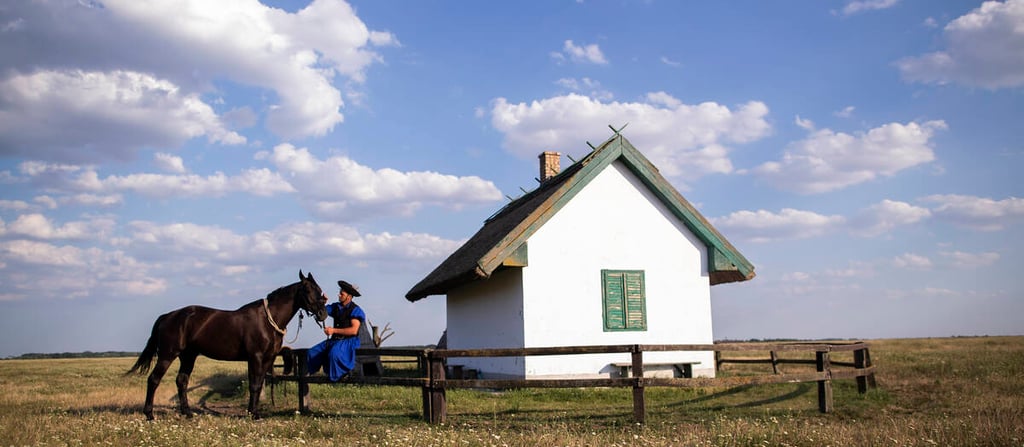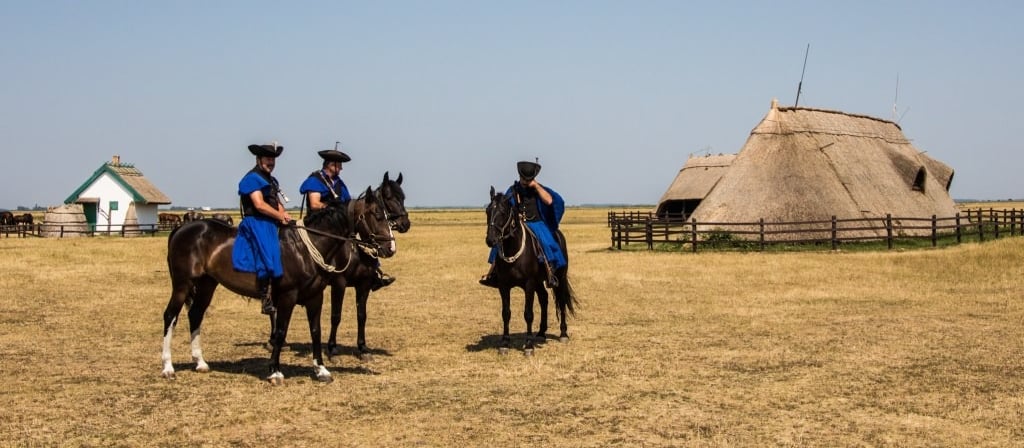Hortobágy National Park
A sweeping expanse of Hungary’s Great Plain where wild horses roam, folklore thrives, and steppe landscapes invite endless discovery


The Essence of the Puszta: Origins and Landscape
Hortobágy National Park, unfolding across nearly 800 square kilometers of Hungary’s eastern plains, represents the last major European steppe—a sweeping landscape defined by endless grasslands, traditional herding heritage, ecological rarity, cultural memory, and wild expanse. Since 1973, it has been recognized as a biodiversity hotspot and UNESCO World Heritage Site, preserving not only rare birds and grazing herds but centuries of pastoral life. From ancient times, these plains supported migratory herders; today, traditional Hungarian Puszta culture continues through iconic symbols like the black Hungarian grey cattle, rustling herds of racka sheep, and the proud Magyar-noster lipizzaner horses. The landscape is a living tableau of soft sandy dunes, shallow alkaline lakes, reedbeds, and the iconic nine-holed lowestarched bridge that spans a shimmering canal. Visitors should approach this national park not merely as a preserve, but as a living heritage site where ecosystems and folklore coexist—where soundscapes of water lilies, migratory flocks, and conditional winds echo human history across centuries of coexistence.
The steppe ecosystem remains astonishingly intact: cloud shadows drift across unbroken grass horizons. This openness shaped local culture, from Puszta songs and storytelling to artisan leatherwork and shepherd traditions. At dawn, wild horse herds gather mist-shrouded ponds; by midday, meadowlarks trill from fence posts. Nature and culture here are interwoven; the herding traditions—gulyás cattle herds, coach-whistling Csikós riders, reed-burning regrowth—reflect centuries of ecological competence and adaptation. Conservation efforts include controlled grazing, reedbed renewal, and migratory bird protection aligning with the East Atlantic Flyway. The result is more than habitat preservation: it is maintaining a human-influenced landscape where biodiversity thrives, folk traditions endure, ecological learning persists, and natural drama unfolds daily.
Visitor Experiences: Tours, Trails, and Encounters
The design of visitor experiences within the park is thoughtful, layered, and flexible. A network of trails leads through reed–lined wetlands, along grass–covered dikes, or into orchards of local fruit trees. A morning walk might deliver stones identified by local geology guides, while an afternoon horse ride offers close-range horse photography. Birdwatchers can visit the Ölyvösdűlő Bird Tower at dusk to see storks coming in to roost on power lines or nests. Horse-whispering sessions teach visitors how to approach wild horses respectfully. Night tours let people see steppe nocturne life, including roving foxes and red deer rutting. These experiences are offered daily but never impose a commercial flavor—they respect the land’s pace, often explaining seasonal changes such as marsh drying or grass renewal. Signage remains minimal, replaced with guided insight or QR code-labeled plant IDs. Roadside benches along flood channels invite rest, reflection, and birdwatching without infrastructure intrusion. For travelers interested in slow travel, the park provides rustic eco-lodges built in reed-and-earth style, where breakfast includes local jams, home-brewed beer, and rare steppe kvász. This open-ended model allows guests to choose a picnic, a promenade, or a sunrise ride—each guided by curiosity, nature intimacy, ethical presence, and regional respect.
Local guides often reveal hidden stories: which part of the Puszta was flooded in 1888 and gave rise to new reed zones, or how 1990s EU subsidies damaged habitat when grazing fell. Such contexts deepen visitor engagement beyond postcard imagery. Educational programs facilitate high-school curricula, university field trips, and citizen monitoring with drone-based wetland surveys. All this reflects the park’s stance: conservation through experience, not exclusion, allowing every visitor to become an ally, not a spectator.
Conservation and Sustainable Management
Hortobágy National Park’s stewardship is built on long-term ecological principles. Grazing remains central—traditional herds of Hungarian Turan cattle and racka sheep manage grassland height and prevent shrub overgrowth. Reed zones are burned seasonally to renew marsh ecology. Water canals are maintained for flood pulse regulation during spring rains. Researchers estimate that over 60% of wetlands regenerated since 2000 thanks to grazing and water flow restoration, supporting booming populations of cranes and frogs. Park managers also monitor climate impacts, noting shifting migration patterns and planning to extend wetlands where rainfall is now sporadic. Local towns collaborate to reduce pesticide runoff, limit roadside shooting seasons, and involve farmers in park funding via eco-tour service partnerships.
Importantly, this management underscores human-nature cooperation. Local shepherd families earn income by breeding heritage cattle; guides and innkeepers work together to direct visitors gently onto steppe bridges or bird towers; craft cooperatives package florals or reed‑woven souvenirs. Tourism is regulated so visitor numbers remain stable and habitat unaffected. The park publishes open‑access ecological data, hosts annual conferences, and allows global researchers access for study. This forward‑looking model ensures the Puszta’s resilience amid climate fluctuations, rural migration, and tourism pressures, anchoring the belief that nature thrives when culture nurtures it.
Practical Information
Hortobágy National Park is located in eastern Hungary, approximately 200 km east of Budapest and easily reachable via train to Hortobágy station and local shuttle. The park is open year-round, with visitor centers and interpretive trails accessible from early spring through late autumn; winter access remains possible with limited services. Tickets vary: entry to plains is free, but guided tours, bridge crossings, exhibition museums, and horse-ride packages carry modest fees (usually 2,000–4,000 HUF). The park provides multilingual guides (English, German), rentable binoculars, farming gear displays, and eco-lodges or camping zones at the edge of the plains. There are no large cafeterias inside the core park, but Csárda taverns at entrance zones offer traditional stew, roasted lamb, and steppe bread. Visitors must wear closed shoes on trails and may bring water; drone use or off-trail walking requires pre-registration. Bus and train schedules align with guided tour departures. For seasonal events like crane festivals or shepherd exhibitions, pre-book lodging is recommended. The park is pet-friendly on trails but livestock may roam—owners must keep domestic animals leashed.
Official Links
For schedules, booking details, educational programs, and trail maps, visit:
https://www.hnp.hu/
Follow updates on conservation, wildlife migration, and park events on:
Instagram: @hortobagy_nationalpark
Facebook: Hortobágy Nemzeti Park


Biodiversity and Wildlife Encounters
Hortobágy National Park’s ecological significance is deeply intertwined with its remarkable wildlife diversity. The alkaline steppe lakes and marshes provide critical breeding grounds for species such as grey herons, spoonbills, ferruginous ducks, and wading shorebirds. In migration seasons, the region becomes a wildlife spectator gallery—flocks of cranes descend at sunrise over reed-lined reservoirs, common snipe burst from muddy banks, and rare species such as the great bustard soar in pairs over grassland ridgelines. Large mammals like red deer and boar roam the floodplain margins, while the open plains support hardy grazing mammals like Hungarian grey cows and wild horses. Each spring sees ephemeral pools that host crustaceans and amphibians unique to these alkaline waters, while insects like steppe grasshoppers and iridescent butterflies add fleeting color to summer. Importantly, the park employs citizen science projects to monitor avian returns and amphibian cycles. These efforts help safeguard the area as one of Europe’s largest breeding grounds for white-tailed eagles, red-footed falcons, and migrating storks. Thus the park operates as an open-air observatory for ecological dynamics, where breeding habitats, migration corridors, grazing-powered wetlands, species resilience, and natural cycles remain visible and sensitive.
Yet wildlife culture here is active rather than passive. Guided tours allow close encounters with herds guided by traditional Csikós riders, who demonstrate horse-whistling and whips for cattle stamping. Observation towers offer binocular-level views of bird feeding grounds, while horse-drawn carriage tours provide ecological insight with minimal intrusion. Renewable hunting leases fund habitat restoration. Workshops also engage visitors in nocturnal frog listening or insect photography. The national park balances conservation with education and sustainable tourism, proving intimidation-free ecotourism possible when management, tradition and science converge.
Cultural Heritage: Humanity on the Puszta
Beyond wildlife, Hortobágy National Park is steeped in centuries of human story. Its villages preserve wooden barns, shepherd crofts, and sod-straw dwellings built by pastoral peoples. Folk music, Puszta dance, and steppe recipes (such as Hortobágyi palacsinta) are woven into local narration; storytelling evenings in the Csárda taverns pass oral tradition through visitors. UNESCO recognized the Hortobágy as not just a nature site but a cultural landscape, celebrating how grazing, flood control, storytelling, and artisan craft shaped ecological richness over centuries. The park maintains folk craft workshops: rope braiding from reeds, pottery making, leather tanning, and horse furniture weaving—skills once essential to nomadic life now offered to curious visitors. Seasonal festivals include shepherd fairs where herds are judged, folk dancers perform beneath open skies, and local produce stalls display salami, soft cheese, cold brew, and juniper berries, infusing cuisine with heritage expression.
Moreover, the story of Hortobágy entwines with historical events—from Ottoman cavalry routes to Habsburg flood control schemes. Interpretive panels at the Nine-Hole Bridge explain how centuries of water regulation sculpted wetlands and grassbanks. The Csárda taverns serve as both culinary stops and storytelling hubs. Visitors may learn about ancient wetland pasture zones, the impact of 19th-century railway cuts, or how seasonal reed burning supports grass regrowth. Archeological finds, such as Bronze Age artifacts or 12th-century ruins, occasionally surface in park excavations, reminding tourists that human interaction here reaches deep into the past. The park is not a static backdrop; it is a living palimpsest of land management, folk identity, ecological stewardship, and historical continuity.






Awarded with the Highest Distinction
Hortobágy National Park earned the Excellence Award for its extraordinary union of ecological diversity, cultural heritage, pastoral tradition, and educational accessibility. It’s not just a natural reserve but a living landscape where history, biodiversity, and community converge—offering a rare and worthy journey through Europe’s last great steppe, where every horizon opens into memory, nature, and human story.






